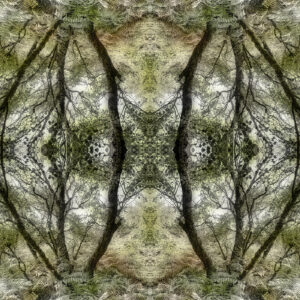Square Mandalas and Facial Pareidolia
Mandalas are usually circular, spiritual geometric configurations that in some religions are depicted as periods of creativity, powerful existence and symbols of deep connection with the self and the universe.
These square mandalas are the result of hours of fun! My starting point was nature – trees to be precise. What I noticed almost immediately was, no matter what image I started with, I ended up seeing faces popping up in all directions. Not necessarily human faces either but animals, imps, devils and aliens!
This led me to research the phenomenon of Facial Pareidolia; the ability to see faces in unusual places. This is a psychological illusion in which the mind responds to an image and perceives a familiar pattern, in this case a face, where non actually exits.

Although many people think that you have to be mentally abnormal to see these types of images, lead researcher Professor Kang Lee [from the University of Toronto] suggests that it’s very common for people to see non-existent features because human brains are uniquely wired to recognize faces. Even when there’s only a slight suggestion of facial features the brain automatically interprets it as a face.
Although this phenomenon has been known for centuries, little is understood about the underlying neurological mechanisms that cause it. In the first study of its kind, researchers studied brain scans and behavioural responses to individuals seeing faces and letters in different patterns. They discovered facial pareidolia isn’t due to a brain anomaly or imagination but is caused by the combined work of the frontal cortex which helps generate expectations and sends signals to the posterior visual cortex to enhance the interpretation stimuli from the outside world.
Researchers also found that people can be led to see different images such as faces or words or letters, depending on what they expect to see, which in turn activates specific parts of the brain that process such images. Seeing the likeness of Jesus in a piece of toast, for example, reflects our brain’s normal functioning and the active role that the frontal cortex plays in visual perception. Instead of the phrase “seeing is believing” the results suggest “believing is seeing.”
This investigation was carried out by: researchers from the University of Toronto, Beijing Jiaotong University, Xidian University, and the Institute of Automation Chinese Academy of Sciences. The findings were published in the journal Cortex.
Story Source:
Materials provided by University of Toronto.
https://www.sciencedaily.com/releases/2014/05/140506115622.htm
Can you see the faces?

